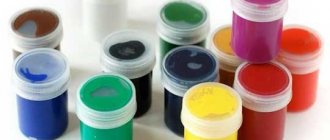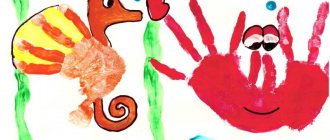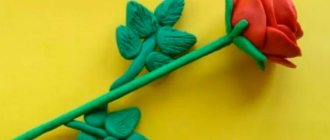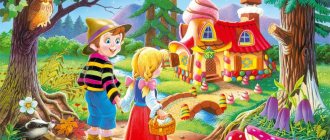Story pictures
Plot pictures on the topic “dishes” are also very useful for speech development. They allow you to compose not only descriptions, but also entire stories.
The pictures “Mom Washing the Dishes” or “Happy Tea Party” help a 3-year-old child come up with a few simple sentences, and at 6 years old the same illustrations can be used to compose a detailed narrative.
Pictures with a plot must be selected for each group of dishes, i.e. the pictures should show a kitchen and a dining room. It’s good if children can see washing dishes, cooking, and decorating a festive table.
Narrative paintings provide an opportunity to practice writing stories, as well as train attention, imagination, and memory.
Tasks in pictures on the topic “Dishes”
In these tasks, the child needs to compare two objects with the same purpose, identify the common and the different. And identify the main essential feature - the purpose of the item (for example, a sugar bowl is needed to store sugar). After all, this is why the sugar bowl has a bottom (so that it stands well on the table), a lid (so that the sugar in it is always clean), and a handle on the lid (to make it convenient to open and close the lid and take sugar). A sugar bowl may have different designs and patterns, it may have handles, it may be porcelain or glass, but this still does not make it a coffee pot or candy bowl. Because it has a different purpose.
Task for children:
The task of coming up with your own sugar bowl and candy bowl for a fairy-tale character (for example, Carlson, who really loves sweets) will help the child show creativity and consolidate his understanding of these objects. After all, when inventing your own item, you need to take into account its features so that the item turns out to be both convenient and beautiful. Children 3-4 years old can be given a silhouette of a sugar bowl to decorate and draw an ornament, and older children 5-6 years old will be happy to play designer and come up with a sugar bowl of the future.
Thematic selection of games and exercises, topic: “Dishes”
Goals:
Expand children's knowledge about dishes and their purposes. Teach children to name an object and possible actions with it. Consolidate knowledge about color, size, quantity. Continue teaching children to count objects; learn to understand the concept of “half”. To develop the ability to distinguish non-speech sounds: hitting plastic, wood, metal, ceramics with a spoon. Replenish children's vocabulary on the topic. Strengthen the skills of gluing, sculpting, and finger painting. Develop memory, attention, fine motor skills, coordination of movements.
Equipment:
“Wonderful bag” with doll utensils: pot, cup, plate, frying pan, spoon, knife, kettle. Wooden, plastic, ceramic, metal plate. Plates in yellow, red, green and blue. Colored silhouette pictures of green cucumbers, red apples, yellow pears, blue plums. Sheets of paper with a drawn table, plate and napkins. Silhouettes of cups and a teapot cut out of colored paper. Yellow plasticine. Poppy. A sheet of paper with a picture of a saucepan (kettle). Finger paint. Cardboard “fork” blanks without teeth, multi-colored clothespins. Handkerchief, napkins, cups. Pictures of “flies” cut out of paper. Sheets of paper with dark silhouettes and similar colored pictures of dishes. Plastic vegetables made of two halves, fastened with Velcro, knives. Pyramid in the form of cups. Silhouettes of frying pans, salt dough, knives, and planks cut out of black cardboard. Toy food set, toy stoves, pots and pans. Building material: cubes and bricks. Little nesting dolls. Small toy dishes. Picture of a cup. Plasticine. Audio recordings “Shoo, fly, fly away”, “We are clinking dishes”, “The bear is clinking with a spoon”.
Game situation “What’s in the bag?”
Guys, today there is something interesting for you in a wonderful bag. Lower the handle and take it out. Pot, kettle, frying pan, plate, spoon, cup, knife. All these items can be called in one word - dishes.
Didactic exercise “What is this?”
This is a saucepan. You can cook soup in it. This is a plate. You can put food in it. This is a spoon. You can use a spoon to scoop up food and put it in your mouth. This is a cup. You can pour tea into it and drink it. This is a knife. They can be used to cut bread. This is a frying pan. You can fry cutlets on it.
Didactic game “Put the food on plates”
Look what products we have: green cucumbers, red apples, yellow pears, blue plums. You need to place these products on plates of the same color.
Applique and modeling “Tea set”
There is a table in front of you (drawing).
Show where the plate, large napkin, and small napkins are on the table. How many large napkins? One large napkin. How many small napkins? Two small napkins. Take the boxes and see what's in them. Teapot and cups.
How many cups? Two cups. How many teapots? One kettle. Place napkins, teapot and cups. There is only one kettle and it is large, so you put it on one large napkin. There are two cups and they are small, so you placed them on two small napkins. Now glue the teapot and cups.
Now it would be nice to make bagels for tea. Take plasticine and roll it out into a thin sausage. Take it by the ends with both hands and wrap it into a ring. Connect the ends. It turned out to be a bagel. Place it on the plate and press down with your palm. Sprinkle poppy seeds on top and press with your finger. Make another bagel in the same way.
Didactic game “What’s missing?”
There are dishes in front of you: a saucepan, a cup, a spoon, a plate. Remember them. Now I will cover the dishes with a handkerchief, and when I open it, something will be missing. What is missing?
Breathing exercise “Shoo, fly, fly away”
A fly flew in and landed on the dishes. - Shoo, fly, fly away! You have no business doing anything on our dishes. Blow on the fly to make it fly away.
(Cut out drawings of flies are distributed to the children. The exercise is repeated several times).
Finger gymnastics “Helper”
Our Antoshka washes the dishes. (Rub your palms apart)
Washes fork, cup, spoon. (Extend your fingers from the fist, starting with the little finger)
I washed the saucer and glass. And he closed the tap tighter. (Imitating hand movement)
Game with clothespins “Fork”
Here is a fork without tines. Make tines on the fork using clothespins.
Didactic game “Setting the table”
In front of you in the picture there are dark spots - shadows. You need to place a suitable shaped dish on top of each shadow: plate, fork, knife, spoon.
Didactic game “Sorting dishes by size”
We washed the dishes clean. We didn’t forget to dry them: Cups and saucers stand in a row And sparkle in the sun.
Make a pyramid of cups. Then stack the cups on top of each other.
Musical and rhythmic exercise “We are clinking dishes”
Children make sounds using various utensils to the song “We Clink the Dishes.”
Finger painting "Pan"
Color the pan: put a fingerprint in the empty circles and paint over the stripes.
Reading the poem "Dishes"
Girl Irinka was putting things in order. Girl Irinka said to the doll: “The napkins should be in the napkin holder. There should be oil in the oil can. There should be some bread in the bread bin. What about salt? Well, of course, in a salt shaker!”
Bas-relief modeling “Decorate the cups”
The cups are new for Mitya. So that he can drink tea, milk and lemonade. We need to decorate the cups.
Pinch off pieces of plasticine and roll into balls. Apply to the cup and press.
Musical and rhythmic exercise “The bear clinks with a spoon”
(Performed to the song of the same name).
Construction “We are waiting for guests”
The nesting dolls are going to come visit us. The nesting dolls are small and it won’t be possible to seat them at our large table, so we need to make small tables and chairs for the nesting dolls. Take a cube, place it in front of you, and place a brick on top of the cube. Like this. The result is a table. Now let's make a chair. Place it near the table, and place a brick behind it. Like this. (Vertical). The result is a chair with a back. And here are the nesting dolls! Have them sit on small chairs. And put the dishes on the table.
Examining plates made from various materials
Here are the plates in front of you. Let's count them. One two three four. How many plates are there in total? Four plates. All plates are different. Here is a ceramic plate that is well known to everyone. Tap it with a spoon and listen to the sound you get. Here is a metal plate. Tap the spoon on it too. Here is a plastic plate. Tap it. But the plate is wooden. Knock on this plate too.
Didactic exercise “Tricky spoon”
We will play with a spoon and name the dishes.
Close your eyes, come on, guess which plate the spoon is knocking on.
Didactic game “Cut into two halves”
Using plastic knives, children “cut” vegetables into halves (secured with Velcro).
How many pieces did you cut your product into? Let's count: one, two. You cut it into two halves.
Modeling salt dough “Pancakes in a frying pan”
Roll out the dough straight into a thick sausage. Cut the sausage into pieces with a knife. Squeeze each piece between your index finger and thumb, place it on the pan and press.
Exercise “Cooking lunch”
There are dishes in front of you: a pot and a frying pan. Take the food, put it in a pot or pan and put it on the stove.
The effectiveness of speech therapy classes in kindergarten and at home very much depends on the quality of visual material selected by adults. Bright, varied pictures of dishes for preschool children help to carry out exercises and games that promote:
- enrichment of vocabulary;
- training skills in writing a story;
- correct use of grammatical structures of the native language.
If you choose high-quality images, then children will be much more willing to complete tasks, and positive results from classes will appear much faster.
Here are some tips to help you organize visual activities for your children.
- All cards must be thick enough, with accurate realistic drawings, with detailed images of objects. It is best to find a ready-made set of drawings for kindergarten or download images for this article.
- Give your child the opportunity to first just get acquainted with the pictures for the activity. Let him look at them carefully and ask clarifying questions about the drawn objects. Play "shop" or "memory" with them. Offer to collect cut pictures. You can connect several cut cards from a thematic set and invite your child to “clean up the mess.”
- For classes, you need to find both subject images on a specific topic, and plot ones.
- With one set of pictures or plot drawing, you need to carry out as many different speech therapy games as possible, this will allow you to use all the possibilities of visual material.
- It is necessary to select cards for classes that depict objects and scenes that are well known and understandable to children. The younger the baby, the more relevant this rule is.
Review of materials for making tableware
Various materials are used to produce tableware - metals, ceramics, clay, glass, porcelain, plastic, silicone. The choice of material is determined by the purpose and operating conditions of the kitchen utensil or cutlery.
What are kitchen utensils made of?
The first dishes were made from clay ; after firing, they became durable and could withstand high temperatures in the oven and exposure to water. Nowadays, some types of kitchen utensils are also made from clay and its “descendant” ceramics. These are baking pots, ducklings, baking dishes, pans.
Kitchen utensils made of ceramics and clay can be placed in the oven, but sudden temperature changes should not be allowed. When cooking on a gas stove, use a flame spreader. reinforced metal bottoms on sale . These models are suitable for all types of stoves, including induction and gas.
The most popular utensils in the modern kitchen are metal . For production, types of metals that are safe for humans are used:
- Cast iron is one of the best materials for cookware, durable and practical. Cast iron has natural non-stick properties, retains temperature for a long time, and is not afraid of fire and heat.
- Food-grade aluminum is a durable and strong metal that does not need to be coated with protective enamel. Aluminum cookware is produced by casting and stamping. To protect against burning, pans and pots are coated with non-stick compounds.
- Black steel is a durable metal that is resistant to deformation and high temperatures. Requires enamel coating.
- Stainless steel is a completely inert material, is not afraid of acids and alkalis, can withstand temperature changes and does not lose its properties when scratched.
- Copper is an expensive raw material used for exclusive cookware or some of its types, for example, frying pans for open fires and coffee pots.
Glass came into the kitchen with the advent of microwave ovens and electric stoves. Pots and roasting pans are made of heat-resistant glass, but a flame divider is still needed on a gas burner.
Silicone is new in the kitchen. All housewives already have silicone molds for ovens and microwaves, but pots and kettles with a metal bottom for gas and open fire still arouse interest and mistrust.
Tableware materials
Dinnerware is not exposed to high temperatures and fire, so there is no need to use heat-resistant materials. But there are many other nuances. Manufacturing materials and protective coatings for tableware must:
- be inert to acids and alkalis;
- withstand contact with hot liquids and products;
- do not crack due to temperature contrast;
- Don't be afraid of detergents.
On sale there are tableware made of ceramics, earthenware, porcelain, glass, metals, and food grade plastics. Favorites on the table are ceramics, porcelain, earthenware and glass. They are used to produce tableware, tea and coffee sets, and other items for table setting.
Glasses, shot glasses, glasses and other glassware for alcoholic and non-alcoholic drinks are made from various types of glass : regular, crystal, heat-resistant, crystal. New - double glass that maintains the temperature of the contents and protects your hands from hot or cold.
Non-stick and protective coatings
To prevent pans from burning and pots from oxidizing from acids, dishes are coated with various types of non-stick and protective coatings. The coating is:
- Teflon;
- ceramic;
- stone (marble, granite);
- titanium.
Read more about the types of non-stick coatings for cookware in our other article. There you will find out which is more reliable and practical.
Cast iron and steel utensils are covered with enamel . Enameling is a complex process, but the coating is durable and scratch-resistant. Enameled pans are suitable for preparing borscht, soups, stews, vegetable dishes and compotes. However, you cannot boil milk in them and you should not cook pasta and dough products - they stick.
Ceramic dishes are coated with glaze. Glazed products are more practical, they do not absorb food and odors, but pots and molds lack pores - a natural regulator of the humidity of prepared dishes.
On our website “Types of Cookware” you will find instructions on choosing the best pots and pans, learn how to choose glasses and cups, and learn how to buy inexpensive cutlery without sacrificing quality. Add the site to your favorites to come to us again!
Games
It is very useful for children’s speech development to conduct didactic games.
- Say the opposite
hot frying pan – fragile cup – shallow plate –
- Compare pairs
The child receives two cards with different objects, and then describes the similarities and differences between them. It can be:
cup – glass deep plate – saucer pan – teapot
- What's extra
Ask the preschooler to choose four from a set of object pictures so that three can be called one word, and one more image would be superfluous. For example:
cup-glass-glass-pan plate-dish-glass-saucer bowl-tureen-cup-teapot
- Match the pairs
Ask your child to find a pair for the piece of utensils you have chosen, and then explain your decision. If a cup is drawn, then he can match it with a saucer, teapot, or glass. In each case the explanation will be different.
- Set the table
Offer to select several items from all the images of dishes:
tea glass kitchen porcelain dining room
- Tell and guess
Place all the cards from the Kindergarten Tableware set on the table. The child must take one picture and come up with a descriptive riddle about the drawn object. For example: large, metal, deep - pan; small, porcelain, fragile - a cup.
- Let's put things in order
Cut out several “cabinets” from paper (for kitchen utensils, tableware and teaware). Then ask to place the images of dishes in the desired cabinet, each type in its own.
- Clean plates
Offer to choose any picture with one piece of utensils and name it, and then count to 5 according to this pattern: “You need to wash one cup, you need to wash two cups, you need to wash three cups...”.
Purpose of the game:
This game will be useful for children of primary preschool age, educators, speech therapists of preschool institutions and parents. The game is multifunctional, so you can use it in several ways.
Goals of the game
: Introduction to color.
Tasks:
Educational: Teach children to distinguish, correlate and name the primary colors: red, yellow, green and blue. Improve the ability to apply a silhouette to a contour. Form spatial representations (bottom, top, right, left). Fix the name of the dish.
Correctional and developmental: Introduce children to the general word “dishes” Learn to coordinate adjectives with nouns (red cup). Develop auditory and visual attention.
Educational: Foster activity and independence in the classroom; friendly relationships between children.
Game equipment:
The game is made of thick cardboard with an image of the outline of dishes of different colors and flat silhouettes of dishes made of multi-colored cardboard.
Classification by purpose and application
According to their purpose, dishes are divided into the following types:
- Kitchen - designed for cooking. These are pots, pans, steamers, kettles, baking dishes and other utensils used for cooking. This also includes cooking utensils - ladles, skimmers, masher.
- Dining room - used for setting the table and serving prepared dishes. This group includes soup bowls, plates, dishes, tea and coffee cups and services, glasses, shot glasses, everything that appears on the table during lunch. The group contains cutlery: spoons, forks, knives.
- storage - all kinds of jars, containers, oil dishes, bottles and containers. Anything that is used to store raw and cooked food. Here there are containers with different temperatures of use.
- Auxiliary - these are additional items such as spice sets, napkin holders, ice buckets.
Types of kitchen utensils
It is impossible to cook dinner without kitchen utensils, so you need to equip your kitchen with these important items. Kitchenware includes:
- Frying pans are heat-resistant kitchen utensils made of metal for frying on the stove and baking in the oven. Frying pans are classified according to the material of manufacture, diameter, depth, shape, type of handles, the presence of a non-stick coating and lid. Read more about the types of frying pans here.
- Frying pans are types of frying pans with a narrower purpose. Dutch ovens are suitable for both stovetop and oven cooking.
- Baking trays are flat metal sheets with low sides. Designed for baking in the oven.
- Pots - utensils for preparing first courses, cooking vegetables, meat, compotes, pasta. There are many types of pans on sale based on their purpose and materials, which we described in this manual.
- Ladles, teapots and milk jugs are small saucepans with one handle for quickly preparing or boiling water (milk).
- Forms for baking bakery and confectionery products. These are all kinds of molds for bread, muffins, pies.
- Forms and portion molds, baking pots. Julienne molds can also be included in this category.
Kitchen utensils also include items that are used outside the stove:
- A colander is a wide ladle with holes for draining water.
- Bowls - containers for washing, cutting, mixing products. It's hard to live without bowls in the kitchen.
- A sieve for sifting flour and straining grounds.
- Mortars are devices for manual grinding of nuts, spices, and seeds.
- Graters and manual choppers for vegetables, garlic, herbs.
- Cutting boards for raw and prepared foods.
In the process of preparing dishes, you cannot do without kitchen utensils . This:
- Skimmers, spoons, spatulas, frying forks and other important little things that help turn food over and mix ingredients.
- Pound for making puree. Progress has made its own adjustments here too, look what potato masher has appeared now.
- Ladles for first courses and compotes.
- Rolling pins for rolling out dough.
- Hammers for beating meat.
- Knives, scissors and other cutting devices.
Additionally, cookware can be classified according to purpose: for boiling, frying, stewing, baking, baking.
Types of tableware
Tableware includes all types of plates, cups, tableware and special-purpose items.
Depending on the size and purpose, plates come in different types:
- Dining rooms are deep for first courses and shallow for second courses with side dishes and independent side dishes.
- Snack bars - small and large, for serving cold and hot snacks. Diameter from 20 to 30 cm.
- Dessert bars with a diameter of 20 mm, for desserts and fruits.
- Pie - for pies, bread, croutons.
- Fish - characterized by an elongated shape.
- Caviar - miniature flat ones for caviar.
- Egg ones - with sides for scrambled eggs.
- Chill is a shell-shaped form used for oysters, stews, and salads.
- Menagerie divided into several compartments. Suitable for serving with sauces and serving several dishes at the same time.
Cups are also different:
- teahouses;
- coffee;
- broth;
- mugs – have a large volume;
- bowls.
Even more types of glasses, goblets and shot glasses. Almost every strong drink has its own glassware. The shape of the glass is not for beauty. It is determined by the aroma, taste and method of tasting. The shape helps the aroma to reveal itself and direct the drink to the right receptors in the mouth.
Cutlery for everyday life and holiday tables
There are two types of cutlery - main and auxiliary. The main ones are intended for individual use. These are spoons, forks, knives served to each guest on the plate. The main group includes tableware, snack bars, fish, dessert and fruit cutlery.
Most often, for serving in everyday life, they make do with a standard set of cutlery. Etiquette enthusiasts can purchase additional fish kits, as well as special forks for spaghetti and crab.
Auxiliary devices are used together at the table. These are various spoons and forks for putting salads and appetizers from common dishes on your plate, spatulas for cakes, tongs for pies and ice.
Cutlery is made from hard metals. For the mass consumer, this is stainless steel, and for lovers of one-piece things - cupronickel and silver . Auxiliary devices can be made of plastic, ceramics, glass, wood.
Poem in pictures “Dispute of dishes”.
For young children, a poem in pictures will help them quickly remember the names of different utensils. And the pictures will help you learn to find common and different things in different objects. Children will get acquainted with a general word - the concept of “dishes”, learn about its purpose and diversity.
And with older preschoolers you can play differently - after reading the poem, each player chooses what kind of dishware they will use. And on behalf of this object, he talks about himself (what he is made of, what parts he has, what he likes and dislikes, what his character is and why he considers himself the most important to people).






